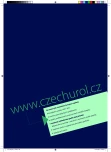Nuclear medicine imaging of prostate cancer
Authors:
Otakar Bělohlávek 1; Ladislav Jarolím 2
Authors‘ workplace:
Oddělení nukleární medicíny – PET centrum, Nemocnice Na Homolce, Praha
1; Urologická klinika 2. LF UK a FN Motol, Praha
2
Published in:
Ces Urol 2012; 16(4): 205-213
Category:
Review article
Overview
Nuclear medicine imaging has been at the disposal of urologists for a number of decades. Alongside scintigraphy, positron emission tomography combined with computed tomography (PET/CT) is becoming widely available for clinical use. A range of radiopharmaceuticals has been reported in recent scientific literature, some of which are now available in the Czech Republic. The significance of this trend is that new and more effective diagnostic modalities have become available for use by practitioners. The aim of this brief communication is to provide a basic review of modern nuclear medicine techniques for imaging prostate cancer. The properties of radioactive glucose and choline derivatives as well as osteotropic radiopharmaceuticals are described. Due to the biological heterogeneity of prostate cancer no particular radiopharmaceutical agent is universally superior. The benefits of nuclear medicine imaging techniques can be seen in the detection of metastases in an otherwise cryptogenic localised disease, and in the timely localisation of biochemical recurrences. In both of these cases early disease detection might change the applicable therapeutic process.
Key words:
diagnostic imaging, nuclear medicine, positron-emission tomography and computed tomography, prostatic neoplasms.
Sources
1. Oyama N, Akino H, Suzuki Y, et al. The increased accumulation of [18F]fluorodeoxyglucose in untreated prostate cancer. Jpn J Clin Oncol 1999; 29 : 623–629.
2. Schöder H, Herrmann K, Gönen M, et al. 2-[18F]Fluoro-2-Deoxyglucose Positron Emission Tomography for the Detection of Disease in Patients with Prostate-Specific Antigen Relapse after Radical Prostatectomy. Clin Cancer Res 2005; 11 : 4761–4769.
3. Gauthier S, Diksic M, Yamamoto L, Tyler J, Feindet W. Positron emission tomography with [11C]choline in human subjects. Can J Neural Sci 1985; 12 : 214.
4. Hara T, Kosaka N, Kishi H. PET Imaging of Prostate Cancer Using Carbon-11-Choline. J Nucl Med 1998; 39 : 990–995.
5. Picchio M, Messa C, Landoni C, et al. Value of [11C]choline-positron emission tomography for re-staging prostate cancer: a comparison with [18F]fluorodeoxyglucose-positron emission tomography. J Urol 2003; 169 : 1337–1340.
6. Fazio F, Picchio M, Messa C. Is 11C-choline the most appropriate tracer for prostate cancer? For. Eur J Nucl Med Mol Imaging 2004; 31 : 753–756.
7. Zöphel K, Kotzerke J. Is 11C-choline the most appropriate tracer for prostate cancer? Against. Eur J Nucl Med Mol Imaging 2004; 31 : 756–759.
8. Picchio M, Spinapolice EG, Fallanca F, et al. [11C]Choline PET/CT detection of bone metastases in patients with PSA progression after primary treatment for prostate cancer: comparison with bone scintigraphy. Eur J Nucl Med Mol Imaging 2012; 39 : 13–26.
9. Pelosi E, Arena V, Skanjeti A, et al. Role of whole-body 18F-choline PET/CT in disease detection in patients with biochemical relapse after radical treatment for prostate cancer. Radiol Med 2008; 113 : 895–904.
10. Cimitan M, Hodolic M, Borsatti E, et al. The potential of 18F-choline PET/CT to detect distant metastases in recurrent prostate cancer with early PSA relapse (< 1.5 ng/ml) when local salvage radiotherapy is intended: the role of Gleason score. In: Molecular Imaging in Radiation Oncology 2012; Vídeň: http://www.miro-online.org/docs/presentations/OP40_Hodolic.pdf.
11. Poulsen MH, Bouchelouche K, Høilund-Carlsen PF, et al. [(18)F]fluoromethylcholine (FCH) positron emission tomography/computed tomography (PET/CT) for lymph node staging of prostate cancer: a prospective study of 210 patients, BJU Int 2012; DOI: 10.1111/j.1464-410X.2012.11150.x. [Epub ahead of print].
12. Jadvar H. Prostate Cancer: PET with 18F-FDG, 18F - or 11C-Acetate, and 18F - or 11C-Choline. J Nucl Med 2011; 52 : 81–89.
13. Heidenreich A, Bastian PJ, Bellmunt J, et al. Guidelines on Prostate Cancer. European Association of Urology 2012 [online]. [Cit. 2012-09-19]. Dostupné z: http://www.uroweb.org/gls/pdf/08%20Prostate%20Cancer_LR%20March%2013th%202012.pdf.
Labels
Paediatric urologist Nephrology UrologyArticle was published in
Czech Urology

2012 Issue 4
Most read in this issue
- Myoglobinuria as a manifestation of rhabdomyolysis following extreme physical exertion
- Nuclear medicine imaging of prostate cancer
- Treatment outcomes of BCG vaccine in patients with T1G3 urothelial cancer – a retrospective analysis
- Retroperitonal liposarcoma in the area of the lower pole of the kidney
